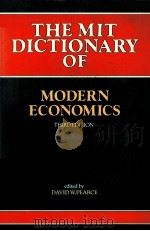《the structure of economics a mathematical analysis third edition P668》
| 作者 | 编者 |
|---|---|
| 出版 | 未查询到或未知 |
| 参考页数 | |
| 出版时间 | 没有确切时间的资料 目录预览 |
| ISBN号 | 无 — 求助条款 |
| PDF编号 | 820550798(仅供预览,未存储实际文件) |
| 求助格式 | 扫描PDF(若分多册发行,每次仅能受理1册) |

1Comparative Statics and the Paradigm of Economics1
1.1 Introduction1
1.2 The Marginalist Paradigm3
1.3 Theories and Refutable Propositions9
The Structure of Theories10
Refutable Propositions12
1.4Theories Versus Models; Comparative Statics14
1.5 Examples of Comparative Statics16
Problems23
Selected References24
Bibliography24
2Review of Calculus (One Variable)25
2.1 Functions, Slopes, and Elasticity25
2.2 Maxima and Minima27
2.3 Continuous Compounding28
2.4 The Mean Value Theorem31
2.5 Taylor’s Series32
Applications of Taylor’s Series: Derivation of the First- and Second- Order Conditions for a Maximum; Concavity and Convexity34
3Functions of Several Variables37
3.1 Functions of Several Variables37
3.2 Level Curves: I37
3.3 Partial Derivatives39
3.4 The Chain Rule45
Second Derivatives by the Chain Rule47
3.5 Level Curves: Ⅱ49
Convexity of the Level Curves51
Monotonic Transformations and Diminishing Marginal Utility53
Problems55
3.6 Homogeneous Functions and Euler’s Theorem56
Problems65
Selected References65
4Profit Maximization66
4.1 Unconstrained Maxima and Minima: First-Order Necessary Conditions66
4.2 Sufficient Conditions for Maxima and Minima: Two Variables68
Problems72
4.3 An Extended Footnote73
4.4 An Application of Maximizing Behavior: The Profit-Maximizing Firm74
The Supply Function81
4.5 Homogeneity of the Demand and Supply Functions; Elasticities82
Elasticities83
4.6 The Long Run and the Short Run: An Example of the Le Chatelier Principle84
A More Fundamental Look at the Le Chatelier Principle86
Problems87
4.7 Analysis of Finite Changes: A Digression91
Appendix92
Taylor Series for Functions of Several Variables92
Concavity and the Maximum Conditions93
Selected References95
5 Matrices and Determinants96
5.1Matrices96
5.2 Determinants, Cramer’s Rule98
5.3 The Implicit Function Theorem105
Problems109
Appendix110
Simple Matrix Operations110
The Rank of a Matrix112
The Inverse of a Matrix113
Orthogonality115
Problems116
Selected References116
6 Comparative Statics: The Traditional Methodology117
6.1 Introduction; Profit Maximization Once More117
6.2 Generalization to n Variables121
First-Order Necessary Conditions121
Second-Order Sufficient Conditions121
Profit Maximization: n Factors124
6.3The Theory of Constrained Maxima and Minima: First-Order Necessary Conditions128
6.4 Constrained Maximization with More than One Constraint: A Digression132
6.5 Second-Order Conditions134
The Geometry of Constrained Maximization138
6.6 General Methodology141
Problems148
Selected References150
7The Envelope Theorem and Duality151
7.1 History of the Problem151
7.2 The Profit Function152
7.3 General Comparative Statics Analysis: Unconstrained Models156
7.4Models with Constraints159
Comparative Statics: Primal-Dual Analysis161
An Important Special Case165
Interpretation of the Lagrange Multiplier166
Le Chatelier Effects169
Problems172
Bibliography174
8The Derivation of Cost Functions175
8.1 The Cost Function175
8.2 Marginal Cost179
8.3 Average Cost180
8.4 A General Relationship Between Average and Marginal Costs181
8.5 The Cost Minimization Problem183
8.6 The Factor Demand Curves189
Interpretation of the Lagrange Multiplier189
8.7 Comparative Statics Relations: The Traditional Methodology193
8.8 Comparative Statics Relations Using Duality Theory202
Reciprocity Conditions202
Cost Curves in the Short and Long Run205
Factor Demands in the Short and Long Run207
Relation to Profit Maximization209
8.9 Elasticities; Further Properties of the Factor Demand Curves211
Homogeneity212
Output Elasticities216
8.10 The Average Cost Curve216
8.11 Analysis of Firms in Long-Run Competitive Equilibrium218
Analysis of Factor Demands in the Long Run220
Problems222
Selected References224
9Cost and Production Functions: Special Topics225
9.1 Homogeneous and Homothetic Production Functions225
9.2 The Cost Function: Further Properties228
Homothetic Functions232
9.3 The Duality of Cost and Production Functions234
The Importance of Duality237
9.4 Elasticity of Substitution; the Constant-Elasticity-of-Substitution (CES) Production Function238
Generalizations to n Factors248
The Generalized Leontief Cost Function249
Problems250
Bibliography250
10 The Derivation of Consumer Demand Functions252
10.1 Introductory Remarks: The Behavioral Postulates252
10.2 Utility Maximization261
Interpretation of the Lagrange Multiplier266
Roy’s Identity268
10.3 The Relationship Between the Utility Maximization Model and the Cost Minimization Model272
10.4 The Comparative Statics of the Utility Maximization Model; the Traditional Derivation of the Slutsky Equation276
10.5 The Modern Derivation of the Slutsky Equation282
Conditional Demands286
The Addition of a New Commodity288
10.6 Elasticity Formulas for Money-Income-Held-Constant and Real-Income-Held-Constant Demand Curves291
The Slutsky Equation in Elasticity Form291
Compensated Demand Curves294
10.7 Special Topics297
Separable Utility Functions297
The Labor-Leisure Choice299
Slutsky Versus Hicks Compensations304
The Division of Labor Is Limited by the Extent of the Market306
Problems310
Selected References313
11 Special Topics in Consumer Theory314
11.1 Revealed Preference and Exchange314
11.2 The Strong Axiom of Revealed Preference and Integrabity322
Integrability325
11.3 The Composite Commodity Theorem332
Shipping the Good Apples Out335
11.4 Household Production Functions341
Comparative Statics345
11.5 Consumer’s Surplus347
Example354
Empirical Approximations355
11.6 Empirical Estimation and Functional Forms357
Linear Expenditure System357
CES Utility Function359
Indirect Addilog Utility Function360
Translog Specifications361
Almost Ideal Demand System362
Problems363
References on Theory366
References on Functional Forms366
12 Intertemporal Choice368
12.1 n-Period Utility Maximization368
Time Preference371
Fisherian Investment378
The Fisher Separation Theorem380
Real Versus Nominal Interest Rates382
12.2 The Determination of the Interest Rate384
12.3 Stocks and Flows387
Problems391
Selected References392
13 Behavior Under Uncertainty394
13.1 Uncertainty and Probability394
Random Variables and Probability Distributions395
Mean and Variance396
13.2 Specification of Preferences399
State Preference Approach399
The Expected Utility Hypothesis400
Cardinal and Ordinal Utility401
13.3 Risk Aversion403
Measures of Risk Aversion405
Mean-Variance Utility Function406
Gambling, Insurance, and Diversification409
13.4 Comparative Statics411
Allocation of Wealth to Risky Assets411
Output Decisions Under Price Uncertainty412
Increases in Riskiness413
Problems416
Selected References416
14 Maximization with Inequality and Nonnegativity Constraints418
14.1Nonnegativity418
Functions of Two or More Variables423
14.2 Inequality Constraints427
14.3 The Saddle Point Theorem432
14.4 Nonlinear Programming437
14.5 An “Adding-Up” Theorem440
Problems442
Appendix443
Bibliography446
15 Contracts and Incentives448
15.1The Organization of Production448
15.2 Principal-Agent Models449
Comparative Statics452
Multitask Agency454
15.3 Performance Measurement457
Choosing the Performance Measure460
15.4 Costly Monitoring and Efficiency Wages461
15.5 Team Production463
15.6 Incomplete Contracts466
Factors Affecting Ownership Structure469
Problems471
Selected References471
16 Markets with Imperfect Information473
16.1 The Value of Information in Decision Making473
16.2 Search474
Sequential Search476
Equilibrium Price Dispersion478
16.3 Adverse Selection482
Favorable Selection485
16.4 Signaling487
A More General Analysis490
16.5 Monopolistic Screening491
Problems496
Selected References497
17 General Equilibrium Ⅰ: Linear Models498
17.1 Introduction: Fixed-Coefficient Technology498
17.2 The Linear Activity Analysis Model: A Specific Example507
17.3 The Rybczynski Theorem513
17.4 The Stolper-Samuelson Theorem515
17.5 The Dual Problem517
17.6 The Simplex Algorithm526
Mathematical Prerequisites526
The Simplex Algorithm: Example530
Problems534
Bibliography536
18 General Equilibrium Ⅱ: Nonlinear Models537
18.1 Tangency Conditions537
18.2 General Comparative Statics Results545
18.3 The Factor Price Equalization and Related Theorems550
The Four-Equation Model556
The Factor Price Equalization Theorem558
The Stolper-Samuelson Theorems559
The Rybczynski Theorem566
18.4 Applications of the Two-Good, Two-Factor Model568
18.5 Summary and Conclusions572
Problems574
Bibliography576
19 Welfare Economics577
19.1Social Welfare Functions577
19.2 The Pareto Conditions581
Pure Exchange581
Production584
19.3 The Classical “Theorems” of Welfare Economics591
19.4 A “Nontheorem” About Taxation594
19.5 The Theory of the Second Best595
19.6 Public Goods597
19.7 Consumer’s Surplus as a Measure of Welfare Gains and Losses600
19.8 Property Rights and Transactions Costs604
The Coase Theorem608
The Theory of Share Tenancy: An Application of the Coase Theorem611
Problems615
Bibliography616
20 Resource Allocation over Time: Optimal Control Theory617
20.1The Meaning of Dynamics617
Brief History621
20.2 Solution to the Problem621
The Calculus of Variations627
Endpoint (Transversality) Conditions629
Autonomous Problems630
Sufficient Conditions632
20.3 Solutions to Di633
erential Equations633
Simultaneous Differential Equations636
20.4 Interpretations and Solutions637
Intertemporal Choice637
Harvesting a Renewable Resource640
Capital Utilization644
Problems649
Selected References650
Hints and Answers652
Index661
《the structure of economics a mathematical analysis third edition P668》由于是年代较久的资料都绝版了,几乎不可能购买到实物。如果大家为了学习确实需要,可向博主求助其电子版PDF文件。对合法合规的求助,我会当即受理并将下载地址发送给你。
高度相关资料
-

- THE MATHEMATICAL GROUNDWORK OF ECONOMICS
- 1924 OXFORD AT THE CLARENDON PRESS
-

- THE GROWTH AND STRUCTURE OF HUMAN POPULATIONS: A MATHEMATICAL INVESTIGATION
- 1972 PRINCETON UNIVERSITY PRESS
-

- A TEXTBOOK OF PHARMACEUTICAL ANALYSIS THIRD EDITION
- 1982 JOHN WILEY & SONS
-

- THE QUANTITATIVE ANALYSIS OF DRUGS THIRD EDITION
- 1964 CHAPMAN & HALL LTD
-

- THE MIT DICTIONARY OF MODERN ECONOMICS THIRD EDITION
- 1986 THE MIT PRESS
-

- THE STRUCTURE OF THE LEGAL ENVIRONMENT OF BUSINESS THIRD EDITION
- 1996 SOUTH-WESTERN COLLEGE PUBLISHING
-

- THE ECONOMICS OF TRADE UNIONS THIRD EDITION
- 1989 THE UNIVERSITY OF CHICAGO PRESS
-

- GROUP THEORY IN PHYSICS
- 1985 World Scientific Publishing Co.Pte.Ltd
-

- THE ECONOMICS OF THE WELFARE STATE THIRD EDITION
- 1998 OXFORD UNIVERSITY PRESS
-

- STRUCTURE OF METALS THIRD EDITION
- 1966 MCGRAW-HILL
-

- A HANDBOOK OF ORGANIC ANALYSIS THIRD EDITION
- 1922 EDWARD ARNOLD AND CO.
-

- A TEXT-BOOK OF MATHEMATICAL ANALYSIS
- 1948 OXFORD AT THE CLARENDON PRESS
-

- ELEMENTARY MATHEMATICAL ANALYSIS THIRD EDITION
- 1925 MCGRAW-HILL BOOK COMPANY INC.
提示:百度云已更名为百度网盘(百度盘),天翼云盘、微盘下载地址……暂未提供。➥ PDF文字可复制化或转WORD

